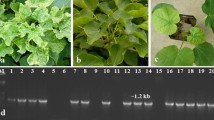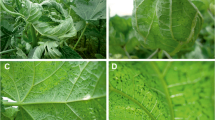Summary.
Virus isolate Y23V, obtained from squash showing leaf curl symptoms in Yunnan, China, was readily differentiated from four studied Chinese begomovirus isolates in reactions with a set of monoclonal antibodies raised against begomoviruses. The complete nucleotide sequence (2714 nts) of the DNA-A-like molecule of Y23V was determined. The DNA-A of Y23V is most closely related to that of tomato yellow leaf curl Thailand virus-[1] (TYLCTHV-[1]) (84% sequence identity). However, the AC1 and AC4 gene of Y23V DNA-A resembled to Pepper leaf curl virus from Bangladesh (PepLCBDV). The DNA-A of Y23V has three distinct regions: the region from 74-2071 nts is 95% identical to TYLCTHV-[1] excluding a 27 nt deletion; the following 386 nts are 91% identical to PepLCBDV and the rest of the DNA-A is not closely related to any reported begomovirus. Y23V, therefore, is considered to have arisen by recombination. The 84% sequence identity of Y23V with TYLCTHV-[1] allows Y23V to be considered as a distinct begomovirus species, for which the name squash leaf curl Yunnan virus (SLCYNV) is proposed.
Similar content being viewed by others
Author information
Authors and Affiliations
Additional information
Received August 5, 2003; accepted May 14, 2003
Rights and permissions
About this article
Cite this article
Xie, Y., Zhou, X. Molecular characterization of squash leaf curl Yunnan virus, a new begomovirus and evidence for recombination. Arch Virol 148, 2047–2054 (2003). https://doi.org/10.1007/s00705-003-0153-2
Issue Date:
DOI: https://doi.org/10.1007/s00705-003-0153-2




